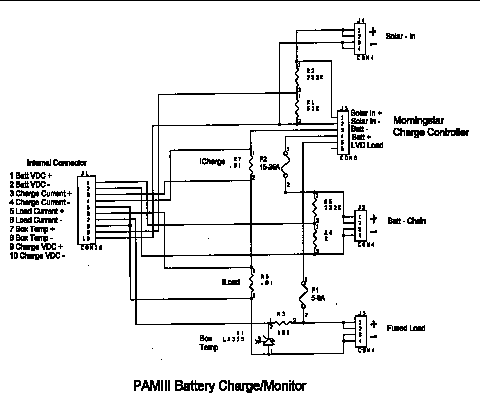PhotoVoltaic System:
PAM stations are normally operated entirely off solar charged batteries. The Flux PAM-III station has relatively high power requirements for a solar charged system. In its Flux configuration, a PAM-III station may require between 4 to 6, 64Watt Solar Panels and 3, 100AmpHour batteries, depending upon the conditions and the sensor configuration.
The solar panels used are Solarex MSX-64 modules (data sheet included). In a simple, non-Flux configuration, the PAMIII station can be deployed with two of these panels mounted directly onto the main tripod assembly. In the Flux configuration two adjustable ground mounting stands are provided, each of which can accommodate 3 panels.
It is straightforward to make a quick estimate about how many solar panels are needed for a particular installation. Amp-Hour Load *1.25 / equivalent peak sun hours = minimum Photovoltaic capacity required. For example, if four panels (~14.4 amps under peak sun), are providing power for a 2-Amp continuous load, then a minimum of 4 hours of equivalent peak sun hours per day are needed. The solar industry typically uses a factor of 1.25, however, for field measurement systems like PAM, it is safer to size systems using a more conservative value such as 1.5.
NCAR uses a commercial photovoltaic charge controller built by MorningStar to manage the battery charging process. This charge controller is designed primarily for lead-acid type batteries, whether they are sealed, gel, or flooded wet-cell. It is a high-efficiency controller (~15mA current requirement) that is considered a constant voltage type of charge controller even though it uses a high-frequency pulse-width-modulation (PWM) technique to apply the actual current. (Note: Lead-Acid batteries typically work better with constant-voltage charging. When operating a solar charging system, `shunt' style charge controllers, which simply jumper the panel output to the batteries, should be avoided.) PWM according to some studies can increase battery life and help prevent sulfation of the electrodes. Like some other solar charge controllers, the MorningStar automatically compensates charging voltages for temperature variations.
Although PAM normally operates as a 12 volt system, the MorningStar also has built-in intelligence to regulate the system at either 12 or 24 volts. If the system is operated at 24 volts, both the battery bank as well as the solar panels should be operated at that level. This means that 3 sets of 2 solar panels would need to be put into a series/parallel connection, and either 2 or 4 batteries would be used. This means that a different set of "PV" and "battery" jumper cables would be needed than what is normally provided with PAM. Also, bypass diodes should be used to prevent back biasing between series connected solar panels. (Back biasing can happen when a significant portion of a solar panel becomes shaded and it shunts energy from others in the string. The excess current can cause overheating of the cells which may reduce efficiency and life of the panel.)
With PAMIII, the charge controller is mounted inside of a `full' sized battery box that includes a (single) battery compartment and a power monitor / fused disconnect board. One of these boards is included with each PAM station. For the Flux configuration, two additional `small' battery boxes are included which are jumpered in parallel from the main charging box. The power monitoring board of the charging system includes voltage dividers and shunt resistors used to send analog signals to EVE for recording battery voltage, temperature, load current and charging current. These signals are typically sampled through EVE's A/D0 port and can be used for ascertaining the health of the power system and its state-of-charge. In fact, the "Battery Test Results" shown in the next section were generated from data sampled by a PAM electronics box. A layout of the monitoring board and full sized battery box appears at the end of this section. If a PAM station goes down, one of the first places to look is at the fuses on this panel to see whether they blew or not.
Normally, the power provided to the `fused load' on the monitor board comes from the MorningStar's terminals labeled `load.' The `fused load' circuit on the monitor board gets distributed to the remote station electronics box `downstream' of the fuse and shunt resistor. The `load' terminals on the MorningStar are internally wired to an automatic low-voltage disconnect (also temperature compensated). This feature prevents batteries from becoming completely discharged and damaged or frozen as a result. Section 7.3 "Battery System" shows the discharge, and disconnect characteristics of two different batteries at room temperature and at 0-degrees. The MorningStar will allow a battery to go down to about 80% of its total depth of discharge. For a fully charged, new battery of the type used in PAM this should equate to about 60-80 AmpHours.
The MorningStar controller and the battery charge monitoring box can be used with other sources of power. For example it can be used with a DC power supply (as with the "A/C power supply system" noted in section 7.4), or a paralleled hybrid system such as Photovoltaic/Wind or Photovoltaic/Electrothermal. The only requirement is that the input current limit of the charge controller is not exceeded.


